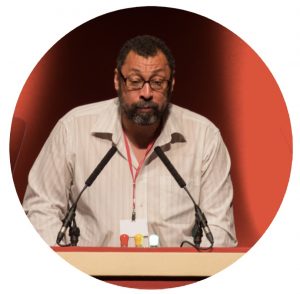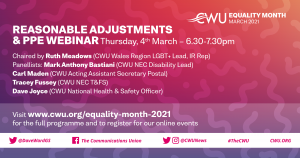CWU Equality Month: The Disability Employment and Pay Gap
Union Matters March 4 2021
Weho / Shutterstock.com
Thursday 4th March 2021
In this first week of Equality Month, we’ve published a series of articles focussing on the fight for fairness for people with disabilities, written by CWU activists.
 Today, Mark Anthony Bastiani reveals details of the disability employment and pay gap…
Today, Mark Anthony Bastiani reveals details of the disability employment and pay gap…
Did you know that there is a 29.8 per cent disability employment gap and a disability pay gap greater than the gender pay gap?
A report compiled by the TUC last October – The Disability Employment and Pay Gap – showed that, in 2019, the employment rate for people with a disability was 51.8 per cent, compared to 81.6 per cent for people without a disability.
And sadly, this is compounded by a further gap of 5.1 per cent affecting BAME people with disabilities.
Geography can make a difference too, with Northern Ireland having the highest disability employment gap of 42.4 per cent, according to the study, while figures for the North East (34.8), Scotland (31.6) and Wales (31.4) all topped 30 per cent.
When we do get a job, and go to work, we expect to be treated fairly and paid accordingly for the work we do, no matter if we have a disability or not.
But a man without a disability was paid, on average, £2.15 more hour than a man with a disability, while among women there was a £1.53 hourly pay gap, which rose to £3.68 when comparing a woman with a disability to a man without a disability.
And if we look at gap variations according to types of disability, the Office for National Statistics published a study in 2017/18 – The Disability Pay Gap – which broke this down and found gaps of close to 40 per cent for men with epilepsy (around 20 per cent for women), and of 30 per cent (men) and 10 per cent (women) for workers with depression and anxiety.
Taking men and women together, the overall gap in pay for workers with a mental disability was 18.6 per cent, while for those with a physical disability it was 9.7 per cent.
So, what are the reasons behind this?
- People with a disability tend to be in lower-paid occupations, some people with a disability may leave education earlier or even when they get the same qualifications, they can be overlooked for a person without a disability.
- There seem to be more people with a disability in part-time work, or employed on ‘zero-hour’ contracts, than people without a disability when it comes to the private sector.
What can we do about this?
- Campaign for mandatory disability pay gap reporting by employers and urge employers to produce targeted action plans identifying the steps they will take to address any gaps identified – such as including ensuring workers with a disability or hidden disability feel confident in completing workplace equality monitoring.
- Call for better education and training and awareness raising. This discrimination may be the result of stereotypes, for example, a widespread belief that we are less productive, it could be lack of understanding of the disability. Training and education are key in breaking these myths.
- Take motions to conference, speak to your local MP and raise the issue with your local councillor.
In this day and age, employers must do more to end the pay gaps that exist and the CWU will continue to support campaigns to bring fairness for everyone at work.
This March is Equality Month at CWU and we will be hosting a range of events, workshops and courses to celebrate. See the full programme here (some details to be added throughout the month) and register for our online events. Our first webinar will be Reasonable Adjustments and PPE. Tonight – 4th March – 6.30-7.30pm. Details below:

Reasonable Adjustments & PPE Webinar
TONIGHT – 4th March – 6.30-7.30pm
Chaired by Ruth Meadows (Wales Region LGBT+ Lead, IR Rep)
Panellists: Mark Anthony Bastiani (NEC Disability Lead), Carl Maden (Acting Assistant Secretary Postal), Tracey Fussey (NEC T&FS), Dave Joyce (CWU National Health & Safety Officer)
Register in advance for this webinar: https://us02web.zoom.us/webinar/register/WN_JzUC7tkPSP2VJsxlbinawg
After registering, you will receive a confirmation email containing information about joining the webinar.

